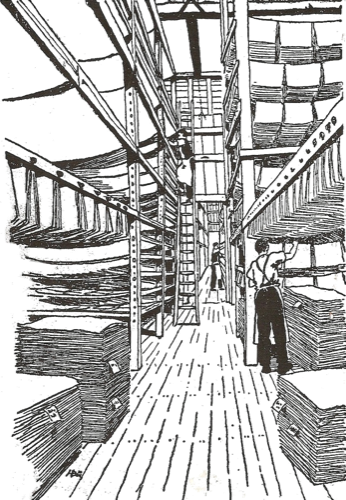The Dryer
The Dryer is a large machine, consisting of four drying cylinders, a feeding felt, three covering felts and one passing out felt. At a thigh high table a woman stands with the packs in front of her. From the packs she strips the sheets off in twos keeping the feeding felt full. When the feeding felt, an endless ribbon, reaches the first cylinder, it passes on to the cylinder, meets the covering felt which takes it to the next cylinder, repeating this until the last felt which carries it out, where another woman waits to gather the sheets from the felts, jogs them up neatly and stacks them ready for sizing.
The Size House
In two steaming tubs, the gelatine, made from Buffalo hide, is melted. To this is added strong smelling ingredients suitable for the paper to be sized. Naturally, trade secrets control the mixture. Alum, it must have, because without it, the animal compound would soon decay. Sizing is done in wooden oblong baths, in hot amber coloured liquid. Two endless blankets with holes punched in them, pass continuously through the liquid.
A woman sits at one end of the machine, with a heap of water-leaf paper, as it is known at this stage, beside her, this she fills in regularly, two sheets together, on to the sizing felt. As it emerges at the other end, after passing through the liquid between the two blankets, another woman lifts each sheet off the felt, looking through the sheet as she does so to see if the sheet has soaked. The sheets are laid before her and made up into four inch wads. These wads are put on to a truck, covered with felts to save the sheets from chilling and sizestaining. Next the parter jostles up the sheets and parts them sheet for sheet, taking care to cover the wads again.
The Drying Lofts
The Drying Lofts are large airy rooms. Cow hair rope lines fill the lofts to the rafters, above which drying fans extract the exhausted air and take away the moisture rising from the drying paper. Below, hot air pipes twist on the floor, from which the temperature can be controlled. In the regulation of heat and air, lies the art of drying, as the paper dries from the deckle edge inwards. The centre of each sheet is the last spot to dry. This demands watchfulness and careful judgement.
With a T-square hand tool, the sized sheets are lifted on to the lines for drying. Another room where the sheets are laid on coarse sacking to dry is known as the flat loft. This is for expensive papers of double elephant and imperial. Much later when clips were installed all paper dried flat, this saved having to break the back of the paper where it had hung over the ropes. Before handmade paper making finished at Tuckenhay a Lister was installed for drying. This was a tall oblong covered machine, divided in half lengthwise by a platform - hot air is blown along the bottom half by a blower, and sucked back through the top half of the machine and taken out of the mill by an exhaust pipe.
This machine has 181 feeding trays, covered in hessian, sheets were filled in in twos. The trays move backwards and forwards, the whole length of the machine, first on the top half of the platform then the bottom half. The sheets are filled in and taken out from the same end. When the paper has dried it is neatly jogged up ready for the glazers.
Reference: The Story of Handmade Paper (1924)
